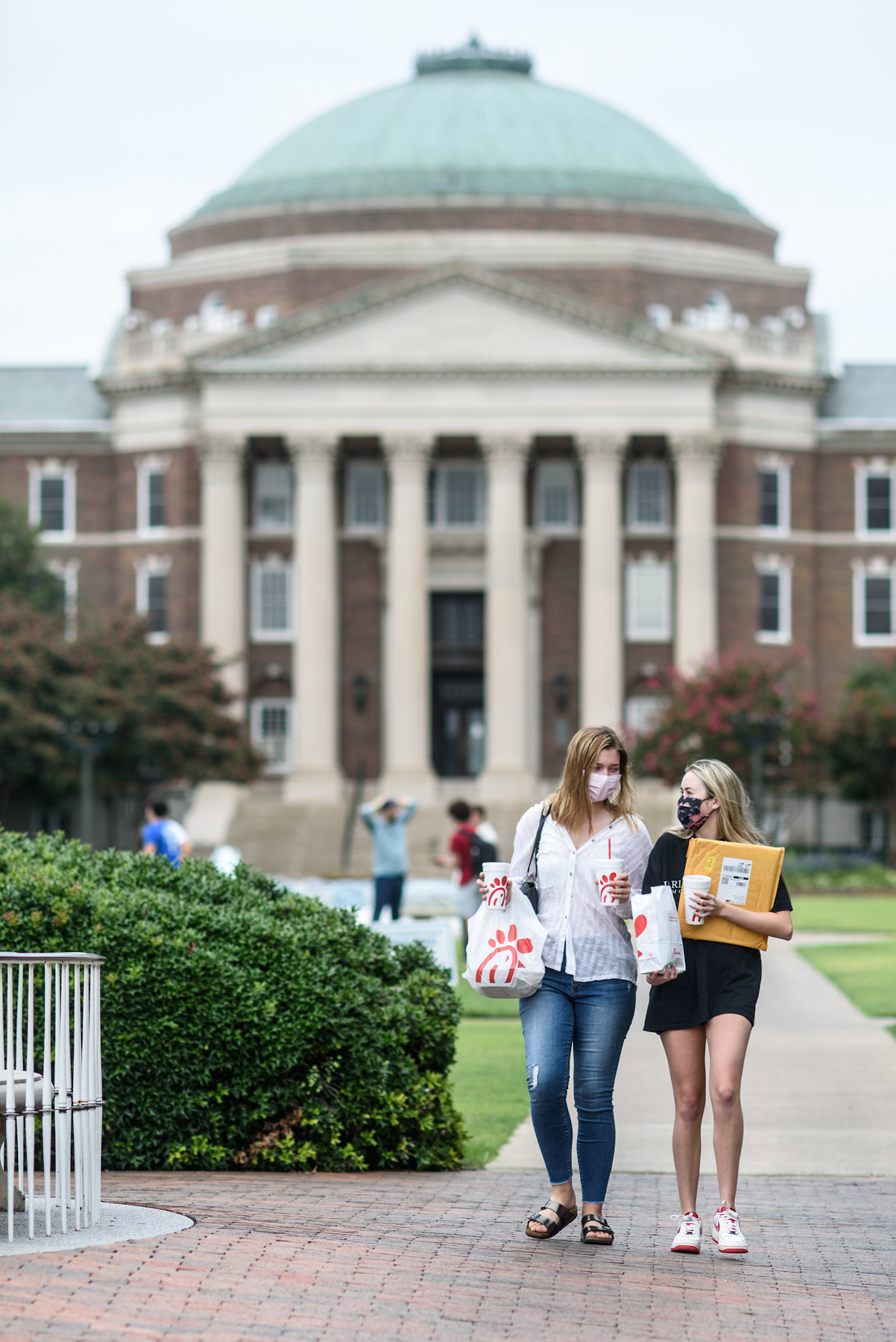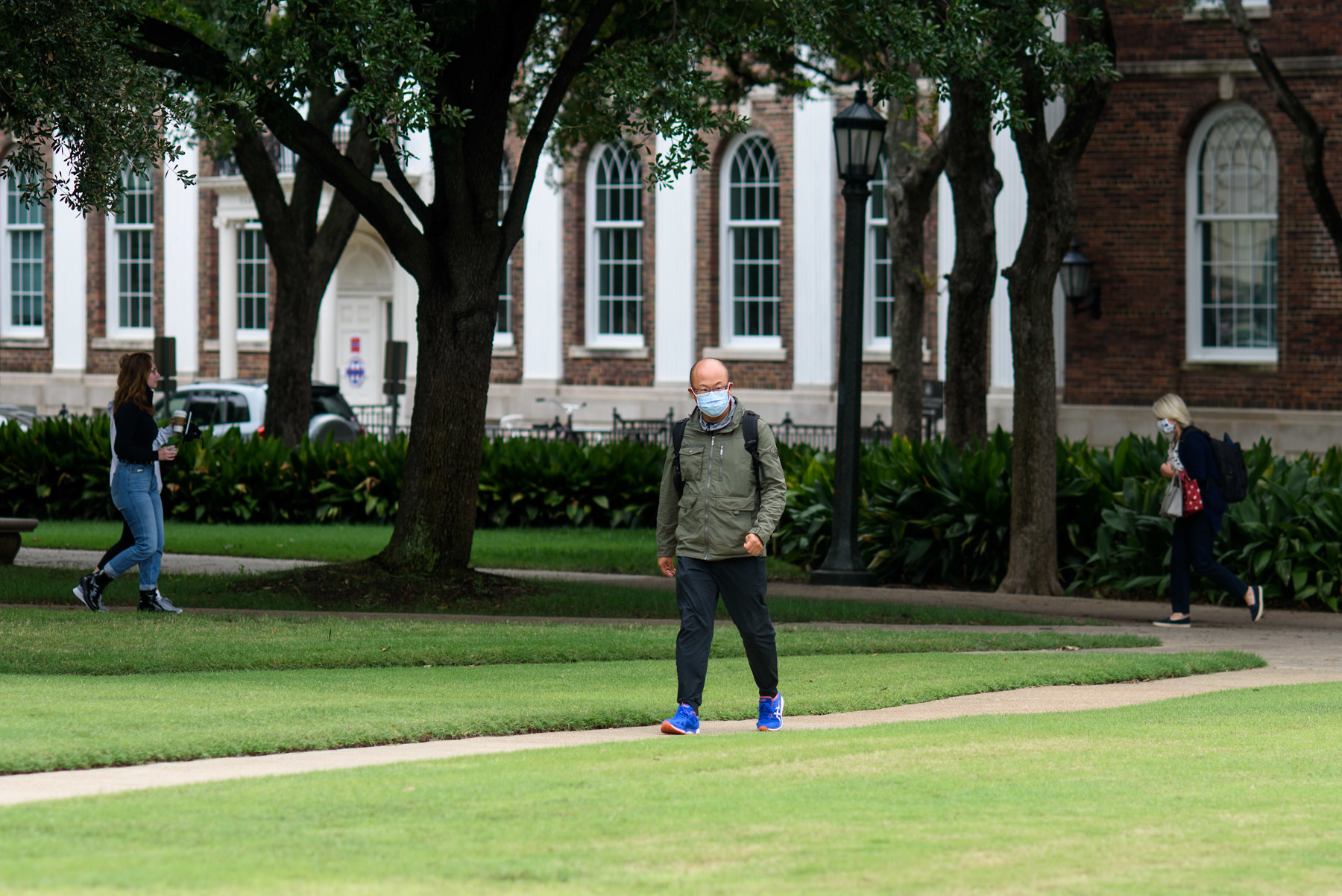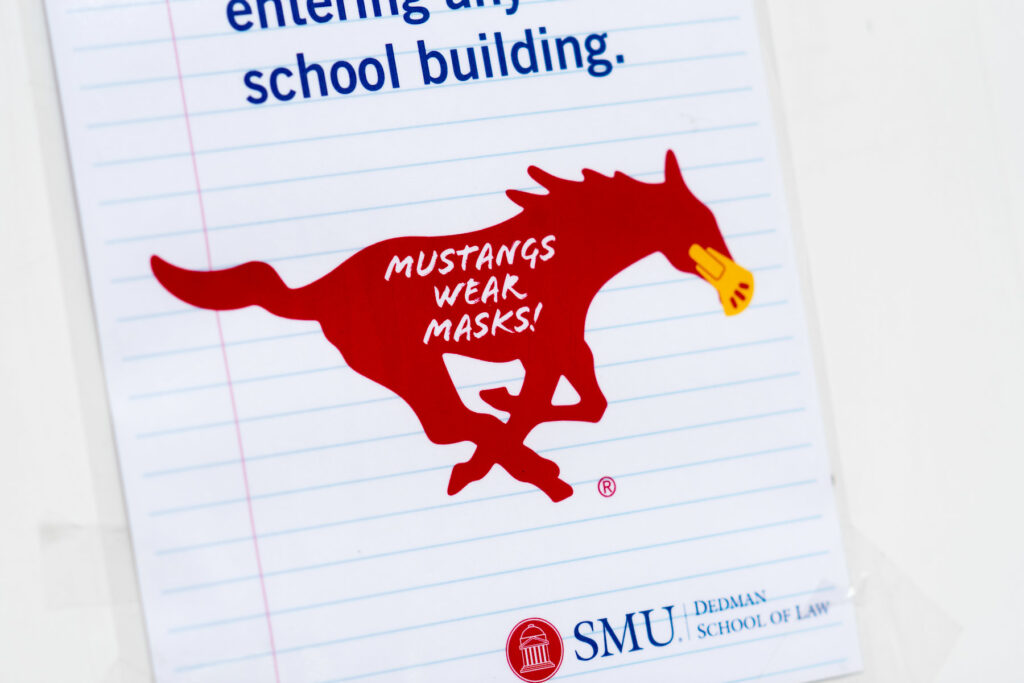More than 100 SMU faculty members have vocalized their concerns about the university’s decision to resume in-person classes while cases of COVID-19 rise on campus. The school ramped into “high operation level” on Tuesday, the third of four levels that indicate the severity of transmission among students.
Upon reaching this level, SMU claimed it would “operate low-density environments” while keeping instruction “primarily remote.” The guidelines say it will limit in-person classes “to practicum activities that are difficult to conduct remotely.” It says it will only allow fewer than 10 individuals to gather and requires “special permission” to do so.
However, the university has chosen to maintain classrooms, academic buildings, libraries, residence halls, dining halls, and other public areas at a “moderate” level, which means in-person classes and activities can continue. This has confused many faculty members, as it appears the assessments are not uniformly administered throughout the university.
Those who have spoken out worry the administration is putting its faculty, staff, and students at risk in order to keep the college experience as normal—and profitable—as possible during a pandemic. They are worried that SMU has not set a threshold of when it would move operations entirely online in the case of significant spread. As of Friday, there were 232 active cases on campus, up from 68 on August 24 when classes resumed.
Tensions rose in July, when more than 800 faculty and staff signed a petition to be given the choice to work remotely for the fall semester without needing to provide a medical justification. The university only allowed faculty and staff to teach remotely if they fell into a high-risk category according to CDC guidelines, regardless of pandemic-related caregiving needs. That means having children and elderly dependents at home wasn’t enough to qualify.
The letter criticized the lack of faculty and staff input in the school’s operations plans in contrast to the students, who were surveyed and given the option to return remotely for the semester. The petitioning group asserted that “faculty and staff should have the same freedom” as students to return to SMU at their own comfort level.
“The university just sort of shot that down as soon as they got it,” says Dan Moss, an associate professor of English. “There was a slow realization that they were going to reopen no matter what, and I think that sort of stunned me, personally.”

President R. Gerald Turner responded to that petition with a letter stating that giving all faculty and staff the option to work remotely was not feasible.
“We have made the exemptions for those individuals whom the CDC guidelines recommend to remain working from home. We need everyone else pulling forward, together,” Turner wrote.
He cited students’ mental health and educational experience, but also money. Only about 16 percent of undergraduate students, 1,100 out of 6,740, have chosen remote learning for the fall 2020 semester, according to a spokesperson.
“There is a financial implication of the virus and, hence, the livelihoods of our faculty and staff and their families,” the letter read. “Not to mention the physical and mental health impacts if employees are furloughed. We continue to run scenarios and the further online we go, the more staff and faculty that would need to be furloughed.”
Robert Howell, chair of the philosophy department, disseminated the letter among his peers. He said he feels that “there was not, frankly, a whole lot of sympathy with the faculty and employees concerned about their health.”
The university’s Fall Operations Plan left many faculty feeling the same way. SMU revealed the plans to faculty on August 5, less than a week before the beginning of residential move-in and 10 days before the start of law school classes. Even now, it appears the university is deploying its guidelines piecemeal, excluding most settings on campus where people congregate.
“In general, the faculty felt like we were left out of the decision-making process,” says Howell.
Right off the bat, there were several concerns. The guidelines only required face coverings, which have been proven to be less effective than masks.
There was an implication that the university would send sick students home–even across the country–if the campus ran out of isolation beds. Those isolation beds are mostly housed in three residential halls on campus, but there are also 15 “self-contained trailers” available. All of those settings have kitchens, WiFi, and are fully furnished, the university said.
The plan also suggested that contaminated spaces would be cleaned within 4 to 8 hours of contamination identification, despite the CDC’s protocol to close the area for at least 24 hours. The petition asked that SMU shutter contaminated spaces for 24 hours after contamination identification for the health of students, faculty, and cleaning staff. The faculty wanted the contract-tracing program to notify anyone who shared a classroom with an infected person or was in a bathroom or kitchen recently that had been used by an infected person. It also asked SMU to test those who shared a space recently used by an infected person.
Finally, the petition requested the university to install toilet lids and close urinals in the restrooms to prevent the spread of the virus through aerosols.
SMU made a few small adjustments in response. Face coverings are still allowed, but the use of multi-ply masks is “strongly encouraged.” Mostly, though, the university responded to faculty feedback by reiterating its original plans.
“There’s a way in which that letter was asking the university to go back in time and make different choices about what their goals for the fall semester were,” says Moss. He and other faculty had come to understand that certain goals–like returning to campus on August 24, filling the dorms, and holding an August commencement–were non-negotiable.
“It’s a willful plan to proceed as usual, and to not take into account the fact that we shouldn’t be gathering on campus in the first place during a pandemic,” says a tenured faculty member, who asked to not be identified for fear of retaliation. “There’s so many ways that they’re willfully looking the other way so as to proceed as they wish.”

SMU also declined to adhere to the CDC’s rule to wait 24 hours before cleaning a contaminated space, arguing that the campus custodial services “have more specially trained teams outfitted with additional PPE, allowing for a rapid response.”
As for notifying and testing students and faculty who shared a classroom or public area with an infected person, the university asserted that its contract tracing program does not require it to do so. The process only identifies individuals who were within six feet of an infected person for more than 15 minutes as a close contact. Those individuals only are alerted and encouraged to self-isolate.
Finally, the plan to send sick students home if the campus runs out of isolation beds remains in place, despite SMU acknowledging that the CDC and its own consultant epidemiologist advise students to isolate on campus as to prevent further spread while traveling. As of writing, 58 of 127, or 45 percent, of isolation spaces are occupied.
“One thing we noticed in the faculty senate was the plan to send students home to isolate if isolation resources became highly used. We shared our concern with Provost (Elizabeth) Loboa at a meeting of the executive committee of the faculty senate back in August,” says associate professor and president of the faculty senate, Aurelie Thiele.
This week, the university announced that it was securing additional isolation space to avoid having to send infected students away from campus.
“We do feel the administration has been listening to our concerns and trying to take action, because they have so many moving parts to deal with. We were pleased to see they’re planning on increasing isolating capacity so that fewer students have to be sent home if needed,” says Thiele.
Page 19 of the Fall Operations Plan states that once 50 percent of isolation spaces are occupied, any student with a permanent address within 120 miles of campus may be required to isolate at their permanent address. As the percentage of occupied beds rises, so does the distance students will be asked to travel home. However, Provost Loboa says concerns about this policy stem from miscommunication.
“We’ve never asked anybody to go home, not a single time,” says Loboa. “The newer guidelines that have just come out within the past few weeks have now recommended keeping students on campus if possible. We’re working to accommodate that by continuing to identify additional isolation units…we want to make sure we don’t run out of this space.”
Miscommunication seems to be a theme. When SMU announced that it was shifting to “high operational levels” this week to reflect an increase in cases, many faculty and students were left wondering what that even meant. Despite the designation, most areas of the campus will continue to operate at the “moderate” level, with no adjustments to in-person classes or activities. The main changes include the increase in isolation spaces and extended hours at the health center.
Loboa says that SMU’s contact tracing program suggests that students are spreading the virus primarily through off campus activities. “The data shows we’re not having transmission in dining halls, we’re not having transmission in offices, employee to employee, we’re not having transmission in classes,” she says.
Thus, the school decided to apply the higher operational level only where needed.
“It seems that the thinking is students are getting COVID perhaps because of off campus gatherings–I don’t know what data they have to support this,” says Thiele. “So, it would be good if they were communicating a little more, how they came to the conclusion that they have the letter.”

The university relied on data from its contact tracing program and the medical expertise of UT Southwestern chief epidemiologist (and SMU alumni) Dr. Robert Haley to inform its decisions, Loboa said. The emergency operations committee includes Dr. Randy Jones, the university’s executive director of health services. SMU has also been working in tandem with Dallas County Health and Human Services. Some faculty worry it’s not enough.
“If you look across the country, more than half of the universities have retained panels of public health experts, have followed the guidelines that they’d suggested, and have refused to kind of engage in this wishful thinking about public health,” says the anonymous faculty member. “We’re putting our well-being in the hands of 18 to 24 year olds, and they’re being asked to sign pledges to behave in a certain way. That’s not a good public health plan.”
The school says its campus health center is capable of meeting a “high volume” of testing, with a maximum of 60 tests per day. Currently, an average of 35-40 students test per day Monday through Friday. There’s no accounting for students who travel outside of Dallas County to get tested and fail to report their results. As of September 11, SMU counts 232 active cases among students and three active cases among employees.
Loboa says the low employee infection rate is a triumph on the part of the university.
“Our percent positivity is way down,” she says. “I think that’s a real testament to how safe of an environment it is, and also to the commitment of our faculty, students, and staff to making sure we all take our personal responsibilities very seriously.”
The semester is young. Thirty new cases were reported on the campus on September 9, and 16 of the infected individuals had been on campus the same day. Further spread among the SMU community–and its surrounding areas–is likely inevitable. The question is, if the situation continues to escalate, when will the university pull the plug on in-person operations?
“I was concerned that there wasn’t a very clear off ramp to determine, when and if the crisis got bad enough, when we would decide to go completely remote,” says Howell. “It didn’t seem to me that there was a very clear way that we could tell when we had reached that point.”
Provost Loboa says that the university has not determined a specific point at which it would close the campus and move to remote operations.
“This is why we evaluate our situation every week. The emergency operations committee is meeting almost daily now. They have these standing meetings to evaluate our situation and we adjust as needed,” she says.
While some faculty, like Thiele, say they feel comfortable and optimistic with SMU’s plan, others are disappointed and believe the university put its faculty, staff, and student body at risk.
“I just thought that events and realities would overtake a kind of eagerness to open,” says Moss. “I kind of just slowly realized that this was not what was happening here.”
While dozens of faculty members have come forward to complain, it’s likely many others–like adjunct professors, lecturers, staff, and the cleaning crews who are being exposed to infected rooms–have remained silent out of fear for their job security, Howell says.
“People who aren’t tenured feel that they probably can’t speak out in the same way that tenured professors can,” says Howell. “They feel like they need to basically do what the administration wants them to do and feel less able to stand up against them.”
On Thursday, the campus looked like it was closed for a holiday, populated only by students who chose to stay in Dallas than go back home. A couple dozen students would walk out of buildings every half hour or so, but never enough to rise to the level of pre-pandemic traffic. Most students were masked, although some pulled theirs down once they got outside.
The anonymous source is a longtime, tenured faculty member. For this person, watching SMU’s response to the crisis has been a disillusioning experience. In their opinion, the university is experimenting with people’s lives and failing to take responsibility.
“It’s pinning it on the students by making them sign the pledge and by saying that we can do this as long as the students follow the rules. Then it’s also absolving itself of responsibility. It’s just better to open up for business and then you can’t possibly be liable, because how could you possibly figure out who was responsible for the outbreak of COVID-19 that destroyed people’s lives, that maybe ended in the death of some people?
“I said to my students, ‘You guys don’t need to worry. This university is going to make the right decisions. It’s going to look after you. Have confidence that that is the case. We’re going to make the best decision possible and you don’t need to worry. Take my word for it.’ I will never ever be able to say that again about SMU.”





